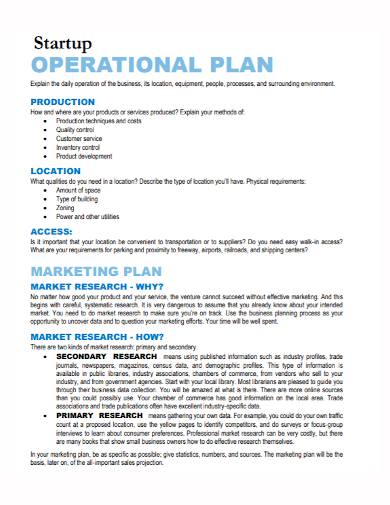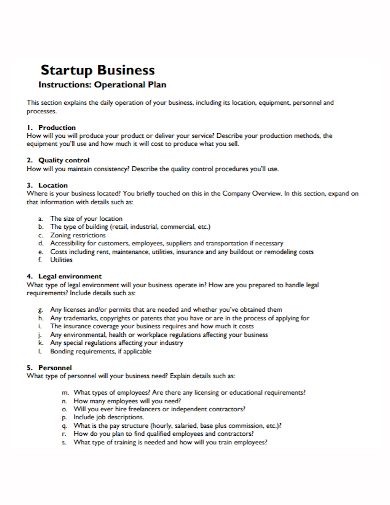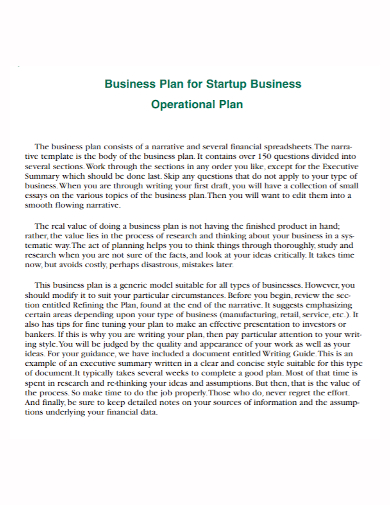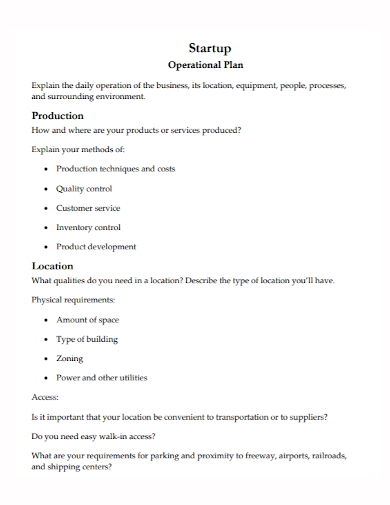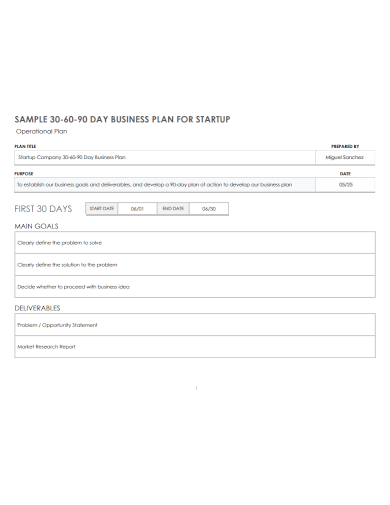Every entrepreneur must have a business plan from the beginning. Your business plan will help you stay focused during the early stages of your company when it’s easy to get sidetracked. A written business plan can assist you in returning to your original concept. Operational, strategic, tactical, and contingency plans are the four types of business plans. The operational plan, or the activities that an entrepreneur-owner must do, will be the focus of this section. The core business activities, as well as how they interact with customers, are critical to a company’s long-term success.
5+ Startup Operational Plan Samples
An operational plan specifies how each department of a company will streamline its business processes in order to meet a set of objectives for the coming year. To maximize workplace accountability, successful companies write operational plans to specify their required short-term tasks and workflows. Despite the fact that an operational plan is frequently written separately from other proposals, startups frequently include it as part of a larger business plan. Investors are given an operating plan to evaluate a company’s organizational structure, assets, and long-term financial needs.
1. Startup Operational Plan Template

2. Startup Operational Marketing Plan
3. Startup Business Operational Plan
4. Sample Startup Operational Plan
5. Startup Production Operational Plan
6. 30-60-90-Day Startup Operational Plan
Creating Start-up Operational Plan
Writing an operating plan is not difficult. An operating plan is a list of everything you want to accomplish in the next 6–12 months as a business. Consider it a month-by-month to-do list for every aspect of your business. An operating plan is a spreadsheet with a column for each month that contains the most critical information for moving your startup forward.
- Plan for what you can see – No start-up has the foresight to look beyond the next six to twelve months. Make plans for what you can see. Over the course of your operations plan, you must pass through certain gates before moving on to the next, eventually arriving at the milestones that represent true business progress. A good operating plan will include a few of these gates to aid in decision-making based on objectively measurable criteria.
- Update your plan regularly – There is no such thing as a “completed” operating plan. Things change quickly; circumstances change; and by the time you finish writing the plan, some aspects of it will have become obsolete. Although updating is necessary, it is possible to update the document too frequently. It’s a good idea to update the operating plan twice a year. Make a plan at the end of the calendar year and revisit it in the middle of the year.
- Make trade-offs – The cash flow in and out of your business is the most important number to keep track of. The simplest way to incorporate this into an operating plan is to use a maximum burn rate. A good operating plan can help you spot when your burn rate is higher than you expected. This gives you enough time to correct your course. If you sell more than you anticipated, you’ll have more money coming in, and the plan will have a little more leeway. To further accelerate your plans, you might be able to make a hire sooner, spend more on consultants, or put more money into marketing. If you’re not selling as much as you expected, or if product development is costing you more than you expected, the opposite should happen. Reduce your burn rate by slowing down and spending less on marketing, delaying team expansion, or letting people go.
- Maintain the discipline – Your best chance of meeting or exceeding your goals is to maintain the discipline to sit down and write a month-by-month operating plan. The most common blunder is that many founders underestimate the time it takes to ramp up. In the hardware industry, for example, you’ll almost certainly require the services of a contract manufacturer. This means you’ll need to factor in a number of lead times when planning tooling and manufacturing.
FAQs
What is the key to having an effective operational plan?
The key to a successful operations plan is to have a clear objective and goal that everyone is working toward. Your operational goal is distinct from your company’s overall goal. Your operational goal explains how you plan to achieve your strategic goal.
What to include in the operational plan?
An operational plan section explains the assets, costs, and resources required to run the business on a daily basis. To reaffirm what is required to begin operating, these requirements are outlined to investors and other involved stakeholders. It also shows that the company understands the various production and delivery activities that are required to produce high-quality goods and services.
Your operations plan allows you to demonstrate to investors that you understand how you want your company to operate. You know who you want to hire, where you want to work, and when projects should be finished.
Related Posts
FREE 7+ Fashion Business Plan Samples in PDF
FREE 10+ Sprint Planning Samples In MS Word | Google Docs | PDF
FREE 10+ Wedding Planning Samples in MS Word | Apple Pages | Powerpoint | PDF
FREE 9+ Monthly Study Planner Samples in PSD | Illustrator | InDesign | PDF
FREE 9+ Sample Curriculum Planning Templates in PDF | MS Word
FREE 10+ Teacher Development Plan Samples in MS Word | Google Docs | Apple Pages | PDF
FREE 10+ Basketball Practice Plan Samples in PDF
FREE 12+ School Business Plan Samples in PDF | MS Word | Apple Pages | Google Docs
FREE 7+ Client Strategic Plan Samples in PDF | MS Word
FREE 11+ Trucking Business Plan Templates in PDF | MS Word | Google Docs | Pages
FREE 7+ Small Hotel Business Plan Samples PDF | MS Word | Apple Pages | Google Docs
FREE 14+ Bakery Business Plans in MS Word | PDF | Google Docs | Pages
FREE 4+ Yearly Lesson Plan Samples in PDF
FREE 50+ Strategic Planning Samples in Google Docs | Pages | PDF | MS Word
FREE 10+ Construction Project Plan Samples in MS Word | Google Docs | Apple Pages | PDF

